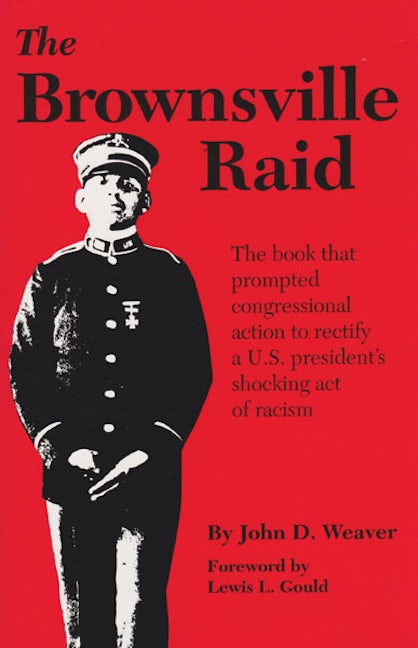

This research guide is intended to encourage the researcher's candid evaluation and interrogation of the historical record. While UTRGV Special Collections & Archives is tasked with providing access to and preservation of our collections, our department does not approve, endorse, or support the attitudes, biases, language, or behaviors found among these materials.
Please do not hesitate to Contact Us if we can improve this research guide, including but not limited to language, description, addition or removal of resources, or access.
This research guide provides a brief summary and background information on the Brownsville Affair (previously referred to as the "Brownsville Raid") while also preparing a list of sources to assist students, staff, and researchers in navigating this research topic. Resources include books, maps, photographs, newspaper clippings, videos, and links to external resources and websites. Additional information for Mingo Sanders has also been included for further research.
On August 13, 1906, citizens of Brownsville, Texas alleged that African-American soldiers with the Twenty-fifth US Infantry at Fort Brown raided the city, resulting in property damages and the death of local bartender Frank Natus. As Garna Christian writes, "The Brownsville [Affair] occurred against a background of deteriorating Negro status: Texas in that same year extended railroad segregation to streetcars, eliminated the black militia, and held the second all-white Democratic primary. The state witnessed over a hundred lynchings between 1900 and 1910, the third highest in the nation." Furthermore, hostility towards African Americans in the Valley had been escalating. In 1875 and 1899, violence erupted between black soldiers of the Ninth (9th) Cavalry and white officers stationed at Fort Ringgold and white residents of Rio Grande City. The occupation of the U.S. military on the border, especially by African-American troops, angered Brownsville's white residents.
Hours before the alleged raid in 1906, a white woman reportedly had been harassed by a group of black soldiers from the 25th regiment, which led Major Charles Penrose to confine all soldiers to their posts that day. That evening shots rang out in the town and local witnesses claimed the responsible parties were a group of Black soldiers from Fort Brown. Immediately after the shooting Maj. Penrose conducted a roll call of all soldiers and a weapons check--the record indicated that all men were present at their barracks that night and all their weapons were accounted for. A formal investigation was conducted by Maj. Augustus Blocksom; his research did not yield substantial evidence on who was responsible for the shooting. President Theodore Roosevelt dishonorably discharged 167 black troops of the 25th Regiment. Six among them were Medal of Honor recipients.
The highest-ranking soldier to be dishonorably discharged was First Sergeant Mingo Sanders of the 25th US Infantry B Company. Sgt. Sanders was a distinguished career soldier who received combat experience in Cuba during the Spanish-American War, having served under Theodore Roosevelt's command. Sgt. Sanders was also a participant in the historic US 25th Infantry Bicycle Corps on their experimental 1,900-mile journey.
With the help of Mary Church Terrell, Sgt. Sanders and Pvt. Elmer Brown, both of the Twenty-fifth US Infantry, were eventually able to reenlist into the military on December 12, 1906. Despite widespread public criticism immediately following the conviction of 167 soldiers, a reexamination of this incident did not occur until the publication of John D. Weaver’s, The Brownsville Raid, in 1970. In 1972 the Army reversed the conviction citing that the events following the Brownsville Affair were not committed at the hands of the Twenty-fifth US Infantry validating their innocence in the historical record.

A cover of the Harper's Weekly magazine, featuring a black and white drawing of Mingo Sanders with his head down holding a piece of paper. At the bottom of the cover are the words 'Dishonorably Discharged.' Next to the full cover is a closeup of Sanders' head and torso, with the writing on the medals and arm-band legible. The writing reads 'One of the best' and 'Nearly 30 years a soldier'.

B Company's Baseball Team, pictured: 1. Harry Carmichael, 2. James Johnson, 3. Edward Daniels, 4. Henry Jones, 5. George Mitchell, 6. Charles E. Cooper, 7. Mingo Sanders, 8. Isaiah Raynor, 9. Wade Harris, 10. John Hollomon, 11. James Allen, 12. Joseph L. Wilson

1973 AP Wirephoto and news clipping of Edward Warfield receiving an honorable discharge from the military 67 years after the Brownsville Affair.

"Edward Warfield, who was in a company of black soldiers accused of carrying out the "Brownsville Raid" at the turn of the century, died today of an apparent heart attack at the age of 89."
Note: Dorsie Willis (not Williams) was the sole survivor.

At 86, Black Resentful of Army Action in Texas Raid
MINNEAPOLIS, Dec. 27 — "Nowadays," said Dorsie W. Willis, "I just sit and eat and think."

DORSIE W. WILLIS, 91, VICTIM OF ARMY BIAS
Ex-Soldier Was Last Survivor of Brownsville Incident in 1906
MINNEAPOLIS, Aug. 24 (AP) Dorsie W. Willis, the last survivor of a company of black soldiers that the Army discharged without honor in the Brownsville Incident of 1906, died today. He was 91 years old.

"Adapted from the map drawn by draftsmen in the Office of the Quartermaster General, for the Court of Inquiry, December,1909". This map includes the houses of people involved in the incident, local businesses, and Fort Brown. From the 1970 book written by John Weaver, The Brownsville Raid.

Cunningham & Co. postcard inscribed, "On the right is the Cowan residence into which the negro raiders fired twenty shots, August 13th 1906 Brownsville, Texas"

Read about the allegations and rush to judgement in "Infamous Outrage." Brownsville Daily Herald (Brownsville, Tex.), Vol. 15, No. 35, Ed. 1, Monday, August 13, 1906; Brownsville, Texas. University of North Texas Libraries, The Portal to Texas History, https://texashistory.unt.edu; .

Citizens of Brownsville rushed to judge the newly arrived Black servicemen despite later accounts that all soldiers were present and accounted for the night of the alleged incident. "Dastardly Outrage by Negro Soldiers." Brownsville Daily Herald (Brownsville, Tex.), Vol. 15, No. 36, Ed. 1, Tuesday, August 14, 1906. University of North Texas Libraries, The Portal to Texas History, https://texashistory.unt.edu; .

A northern newspaper offers a different account of the Brownsville Affair. "Negro Soldiers Are Indignant." Fort Wayne Sentinel, 9 Nov 1906, p. 13. Fort Wayne, Indiana. Retrieved from https://www.fold3.com/image/268989784

"Soldiers Have Chance." The Washington Post, 12 Dec 1906, p. 2. Washington, DC. Retrieved from https://www.fold3.com/image/208317326
See also the blog "Riders of the Bicycle Corps" for the transcription of the Washington Post article: http://bicyclecorpsriders.blogspot.com/2009/01/mingo-sanders.html
TR ordered the dishonorable discharge of 167 soldiers of the 25th Infantry
Samantha Bustillos earned a Master of Arts in Interdisciplinary Studies (MAIS-Anthropology) at the University of Texas at Rio Grande Valley (2021). Ms. Bustillos earned a Bachelor of Arts in History with a minor in Anthropology at UTRGV in 2019. She worked at UTRGV Special Collections as an intern and later student assistant while earning her degrees. Samantha is a Benjamin A. Gilman Scholar and UTRGV Engaged Scholar. As an Engaged Scholar, she conducted and presented her research findings on biracial families in the Rio Grande Valley during the U.S. Civil War at UTRGV ES2 Symposium in 2019. Samantha also served as a docent for the Community Historical Archeology Project with Schools (CHAPS) in collaboration on the traveling exhibit "War and Peace on the Rio Grande." She is now employed with UTRGV University Library as a Library Assistant I.
The research guides compiled by UTRGV staff and students are intended to assist patrons who are embarking upon new research endeavors. Our goal is to expand their knowledge of the types of resources available on a given topic, including books, archival materials, and websites. In so doing, our compilers have taken care to include collections, digital items, and resources that may be accessed not only through UTRGV but also via other institutions, repositories, and websites.
We wholeheartedly respect the research interests of others. Therefore, please contact us if you wish to submit a resource for consideration, or if you have a question about or an issue with a specific cited resource.
 The Brownsville Raid
by
"Around midnight on August 13, 1906, shots rang out on the road between Brownsville, Texas, and Fort Brown, the old army garrison. Ten minutes later a young civilian lay dead, and angry residents swarmed the streets, convinced their homes had been terrorized by newly arrived soldiers. Inside Fort Brown, the alarm was sounded. Soldiers leaped from their bunks and grabbed their rifles, thinking they were under attack by hostile townspeople. The soldiers were black; the civilians were white. Still proclaiming their innocence, 167 black infantrymen of the segregated Twenty-fifth Infantry Regiment were summarily dismissed without honor (or a trial) by President Theodore Roosevelt. "The ""Brownsville"" Raid, " first published in 1970, is John D. Weaver's searching study of the flimsy evidence presented in a 1909-1910 court of inquiry. That court had upheld the president's action and closed the case against the soldiers, not one of whom had ever been found guilty of wrongdoing. The case remained closed until 1971 when, after reading "The Brownsville Raid, " Congressman Augustus F. Hawkins of Los Angeles introduced a bill to have the Defense Department rectify the injustice. Amid a flurry of national publicity, honorable discharges were finally granted in 1972. All were posthumous except for that of Private Dorsie Willis, who received his in a moving ceremony on his eighty-seventh birthday."
The Brownsville Raid
by
"Around midnight on August 13, 1906, shots rang out on the road between Brownsville, Texas, and Fort Brown, the old army garrison. Ten minutes later a young civilian lay dead, and angry residents swarmed the streets, convinced their homes had been terrorized by newly arrived soldiers. Inside Fort Brown, the alarm was sounded. Soldiers leaped from their bunks and grabbed their rifles, thinking they were under attack by hostile townspeople. The soldiers were black; the civilians were white. Still proclaiming their innocence, 167 black infantrymen of the segregated Twenty-fifth Infantry Regiment were summarily dismissed without honor (or a trial) by President Theodore Roosevelt. "The ""Brownsville"" Raid, " first published in 1970, is John D. Weaver's searching study of the flimsy evidence presented in a 1909-1910 court of inquiry. That court had upheld the president's action and closed the case against the soldiers, not one of whom had ever been found guilty of wrongdoing. The case remained closed until 1971 when, after reading "The Brownsville Raid, " Congressman Augustus F. Hawkins of Los Angeles introduced a bill to have the Defense Department rectify the injustice. Amid a flurry of national publicity, honorable discharges were finally granted in 1972. All were posthumous except for that of Private Dorsie Willis, who received his in a moving ceremony on his eighty-seventh birthday."
 Studies in Brownsville history
by
Read "The Brownsville Raid: a historical assessment," by Wally Pierce
Studies in Brownsville history
by
Read "The Brownsville Raid: a historical assessment," by Wally Pierce
 Studies in Rio Grande Valley history
by
"Colored Death: The Tragedy of Black Troops on the Lower
Rio Grande 1864-1906" by Antonio N. Zavaleta, p. 343
Studies in Rio Grande Valley history
by
"Colored Death: The Tragedy of Black Troops on the Lower
Rio Grande 1864-1906" by Antonio N. Zavaleta, p. 343


Appointments are recommended for most new researchers. Our team is available in Brownsville and Edinburg to assist you with identifying resources.